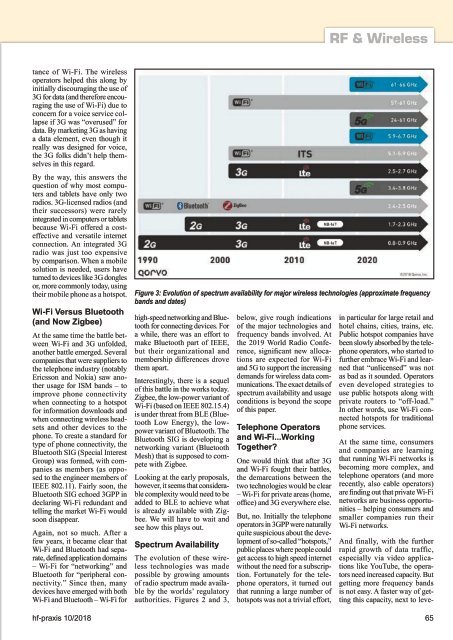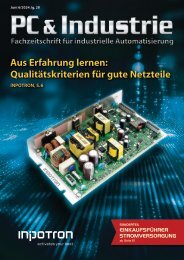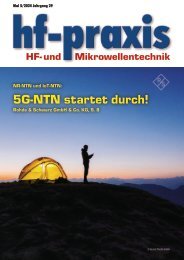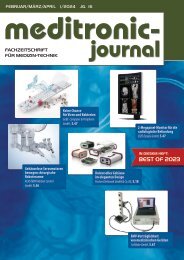10-2018
Fachzeitschrift für Hochfrequenz- und Mikrowellentechnik
Fachzeitschrift für Hochfrequenz- und Mikrowellentechnik
Erfolgreiche ePaper selbst erstellen
Machen Sie aus Ihren PDF Publikationen ein blätterbares Flipbook mit unserer einzigartigen Google optimierten e-Paper Software.
RF & Wireless<br />
tance of Wi-Fi. The wireless<br />
operators helped this along by<br />
initially discouraging the use of<br />
3G for data (and therefore encouraging<br />
the use of Wi-Fi) due to<br />
concern for a voice service collapse<br />
if 3G was “overused” for<br />
data. By marketing 3G as having<br />
a data element, even though it<br />
really was designed for voice,<br />
the 3G folks didn’t help themselves<br />
in this regard.<br />
By the way, this answers the<br />
question of why most computers<br />
and tablets have only two<br />
radios. 3G-licensed radios (and<br />
their successors) were rarely<br />
integrated in computers or tablets<br />
because Wi-Fi offered a costeffective<br />
and versatile internet<br />
connection. An integrated 3G<br />
radio was just too expensive<br />
by comparison. When a mobile<br />
solution is needed, users have<br />
turned to devices like 3G dongles<br />
or, more commonly today, using<br />
their mobile phone as a hotspot.<br />
Wi-Fi Versus Bluetooth<br />
(and Now Zigbee)<br />
At the same time the battle between<br />
Wi-Fi and 3G unfolded,<br />
another battle emerged. Several<br />
companies that were suppliers to<br />
the telephone industry (notably<br />
Ericsson and Nokia) saw another<br />
usage for ISM bands – to<br />
improve phone connectivity<br />
when connecting to a hotspot<br />
for information downloads and<br />
when connecting wireless headsets<br />
and other devices to the<br />
phone. To create a standard for<br />
type of phone connectivity, the<br />
Bluetooth SIG (Special Interest<br />
Group) was formed, with companies<br />
as members (as opposed<br />
to the engineer members of<br />
IEEE 802.11). Fairly soon, the<br />
Bluetooth SIG echoed 3GPP in<br />
declaring Wi-Fi redundant and<br />
telling the market Wi-Fi would<br />
soon disappear.<br />
Again, not so much. After a<br />
few years, it became clear that<br />
Wi-Fi and Bluetooth had separate,<br />
defined application domains<br />
– Wi-Fi for “networking” and<br />
Bluetooth for “peripheral connectivity.”<br />
Since then, many<br />
devices have emerged with both<br />
Wi-Fi and Bluetooth – Wi-Fi for<br />
Figure 3: Evolution of spectrum availability for major wireless technologies (approximate frequency<br />
bands and dates)<br />
high-speed networking and Bluetooth<br />
for connecting devices. For<br />
a while, there was an effort to<br />
make Bluetooth part of IEEE,<br />
but their organizational and<br />
membership differences drove<br />
them apart.<br />
Interestingly, there is a sequel<br />
of this battle in the works today.<br />
Zigbee, the low-power variant of<br />
Wi-Fi (based on IEEE 802.15.4)<br />
is under threat from BLE (Bluetooth<br />
Low Energy), the lowpower<br />
variant of Bluetooth. The<br />
Bluetooth SIG is developing a<br />
networking variant (Bluetooth<br />
Mesh) that is supposed to compete<br />
with Zigbee.<br />
Looking at the early proposals,<br />
however, it seems that considerable<br />
complexity would need to be<br />
added to BLE to achieve what<br />
is already available with Zigbee.<br />
We will have to wait and<br />
see how this plays out.<br />
Spectrum Availability<br />
The evolution of these wireless<br />
technologies was made<br />
possible by growing amounts<br />
of radio spectrum made available<br />
by the worlds’ regulatory<br />
authorities. Figures 2 and 3,<br />
below, give rough indications<br />
of the major technologies and<br />
frequency bands involved. At<br />
the 2019 World Radio Conference,<br />
significant new allocations<br />
are expected for Wi-Fi<br />
and 5G to support the increasing<br />
demands for wireless data communications.<br />
The exact details of<br />
spectrum availability and usage<br />
conditions is beyond the scope<br />
of this paper.<br />
Telephone Operators<br />
and Wi-Fi...Working<br />
Together?<br />
One would think that after 3G<br />
and Wi-Fi fought their battles,<br />
the demarcations between the<br />
two technologies would be clear<br />
– Wi-Fi for private areas (home,<br />
office) and 3G everywhere else.<br />
But, no. Initially the telephone<br />
operators in 3GPP were naturally<br />
quite suspicious about the development<br />
of so-called “hotspots,”<br />
public places where people could<br />
get access to high speed internet<br />
without the need for a subscription.<br />
Fortunately for the telephone<br />
operators, it turned out<br />
that running a large number of<br />
hotspots was not a trivial effort,<br />
in particular for large retail and<br />
hotel chains, cities, trains, etc.<br />
Public hotspot companies have<br />
been slowly absorbed by the telephone<br />
operators, who started to<br />
further embrace Wi-Fi and learned<br />
that “unlicensed” was not<br />
as bad as it sounded. Operators<br />
even developed strategies to<br />
use public hotspots along with<br />
private routers to “off-load.”<br />
In other words, use Wi-Fi connected<br />
hotspots for traditional<br />
phone services.<br />
At the same time, consumers<br />
and companies are learning<br />
that running Wi-Fi networks is<br />
becoming more complex, and<br />
telephone operators (and more<br />
recently, also cable operators)<br />
are finding out that private Wi-Fi<br />
networks are business opportunities<br />
– helping consumers and<br />
smaller companies run their<br />
Wi-Fi networks.<br />
And finally, with the further<br />
rapid growth of data traffic,<br />
especially via video applications<br />
like YouTube, the operators<br />
need increased capacity. But<br />
getting more frequency bands<br />
is not easy. A faster way of getting<br />
this capacity, next to leve-<br />
hf-praxis <strong>10</strong>/<strong>2018</strong> 65

















